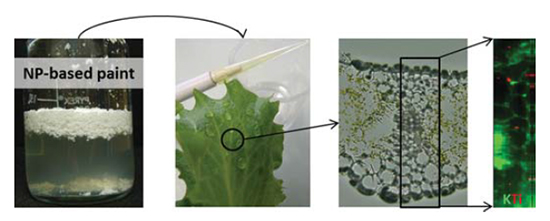A team from Grenoble studied the growth of lettuces, under nanoparticles exposure. In addition to soil contamination, the study focused on airborne contaminants for the first time. Nanoparticles are spreading in many every life products, such as paints for the construction industry.

Nanoparticles (NP) are present in a large number of consumer products. The construction industry, for example, is one of the main sectors using TiO2 nanoparticles, especially in paints. What happens once these NPs are discharged into the wild, whether in the atmosphere or in the soil? Can they be absorbed by plants? What are the consequences? To obtain more information, an ISTerre research group has focused on lettuces in a study published in the Journal of Hazardous Materials. Lettuces were exposed to different concentrations of TiO2 nanoparticles and microparticles, using both TiO2 alone and present in aged (water loaded) paint leachate. The group studied their uptake by root and leaf, but the most original results were obtained on leaf transport, where knowledge is still very patchy. The challenge was to detect extremely low concentrations of NPs or their byproducts.
After 7 days of exposure, the samples were analyzed using different microscopy and/or spectroscopy techniques, including spectro-microscopy studies on the LUCIA (μXANES) beamline. In particular, the researchers wanted to locate TiO2 inside the plants, in order to deduce its pathway within the leaf. Moreover, the speciation of the chemical element (i.e. the different forms it takes) was also closely studied. Géraldine Sarret, heading the study, highlighted the value of using synchrotron radiation: "spectro-microscopy beamlines such as LUCIA enable the precise localization of elements in plant tissues and their speciation can be determined under cryogenic conditions, thus limiting possible redistribution/precipitation artifacts that may occur when using conventional electron microscopy”. The scientists obtained images that suggest that NPs are taken up through the stomata (structures that allow gas exchange) and the leaf cuticle.
In the end, the research group found traces of TiO2 nanoparticles in all the different lettuce tissues. They also discovered that TiO2 microparticles had managed to penetrate exposed leaves. Speciation research did not reveal any transformation of the particles, which remained in their original crystalline form (which is not the case for silver nanoparticles, for example). On the other hand, these studies did not reveal any specific phytotoxicity. This research does, however, raise the question of crops being subjected to airborne contaminants, including nanoparticles, in addition to soil contamination.
